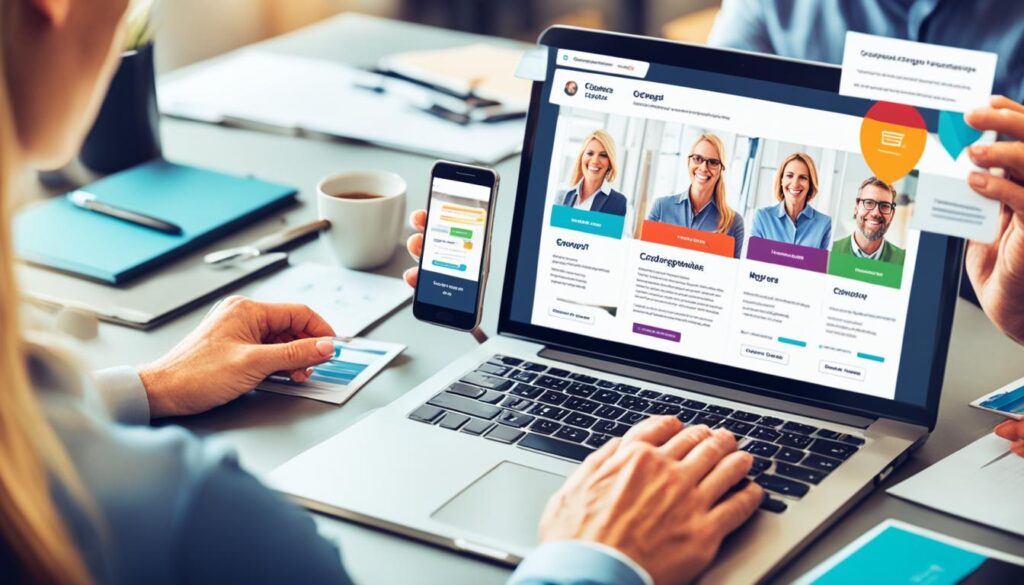In today’s digital age, email marketing remains a powerful tool for businesses to engage and connect with their target audience. But here’s the question: Are you truly maximizing the potential of your email campaigns? If not, fear not! I have some insider tips that will help you take your email marketing to the next level and achieve your marketing goals.
So, whether you’re just getting started or looking to optimize your existing strategies, read on to discover the email marketing best practices and tactics that can make a real difference in your campaigns.
Key Takeaways
- Optimize your email list by focusing on consensual opt-in and building valuable communication.
- Honor unsubscribes and keep your email lists squeaky clean for better engagement.
- Segment your lists based on customer preferences for more personalized and targeted campaigns.
- Embrace the power of personalization to create customized experiences for your subscribers.
- Create compelling subject lines and engaging content to increase open rates and drive action.
The Importance of List Integrity
When it comes to email marketing, maintaining list integrity is vital. Instead of resorting to buying email lists, it is essential to focus on building opt-in only lists. This means that individuals willingly provide their consent to receive your communications, ensuring that you are targeting an audience genuinely interested in your content. By following privacy laws like POPIA, GDPR, and CCPA, you not only adhere to legal requirements but also maintain a positive brand image and establish meaningful relationships with your subscribers.
Opt-in only lists are a mark of trust and respect for your audience’s preferences. By allowing individuals to choose to receive your emails, you engage in consensual opt-in marketing. This proactive approach ensures that you are delivering valuable communication to those who truly want to hear from you, fostering a genuine connection and increasing the likelihood of meaningful engagement.
Building opt-in only lists provides several benefits beyond legal compliance and positive brand image. By targeting an interested audience, you increase the potential for higher open rates, click-through rates, and conversions. Valuable communication exchanged through these lists enhances customer satisfaction and loyalty while reducing the risk of unsubscribes and spam complaints.
“Using opt-in only lists demonstrates a commitment to ethical and effective email marketing.” – Industry Expert
To create opt-in only lists, provide clear and transparent information about the type of content and frequency of your emails. Offer incentives such as exclusive content or promotions to encourage sign-ups. Ensure that your sign-up forms clearly communicate the intent to receive future communication from your brand.
By focusing on list integrity, you prioritize the quality of your subscribers over quantity. This approach leads to stronger engagement, higher conversion rates, and better overall marketing results. So, make sure to invest time and effort into building and maintaining opt-in only lists—it’s a powerful way to connect with your audience and deliver valuable communication.
Keeping Lists Clean and Honoring Unsubscribes
As an email marketer, it is essential to prioritize list hygiene and honor unsubscribes. By keeping your lists squeaky clean, you ensure that your email marketing efforts are targeted and effective. Failure to respect unsubscribes can lead to frustration among recipients and damage your brand’s reputation. Let’s explore why it’s crucial to honor unsubscribes and how to keep your email database clean and up-to-date.
Respecting Subscribers’ Choices
Honoring unsubscribes is not only a legal requirement but also a sign of respect for your audience. When someone decides to opt-out of your email communications, it’s important to acknowledge their choice and immediately remove their profile from your active lists. Continuing to send marketing emails to individuals who have opted out will only result in annoyance and potential complaints, which can harm both your sender reputation and the overall perception of your brand.
The Unsubscribe Page: Gathering Feedback and Reviving Leads
An unsubscribe page is an opportunity to gather valuable feedback from your subscribers and potentially revive dormant leads. When someone clicks the unsubscribe link, redirect them to a dedicated page that offers alternatives and seeks feedback. Provide a simple way for them to update their preferences or choose frequency options that better suit their needs, giving them the chance to remain a part of your email marketing strategy. This approach allows you to gather insights, improve targeting, and maintain a clean email database.
https://www.youtube.com/watch?v=nwkdXLk_-xs
Reviving leads is another vital aspect of managing your email lists. While some subscribers may choose to unsubscribe due to a temporary lack of interest or overwhelming inbox, their preferences can change over time. By saving their preferences and obtaining permission to check in periodically, you create an avenue for reviving leads and reengaging with those who may have initially lost interest. The key is to strike a balance between respecting their choices and providing opportunities for future communication.
Maintaining a Clean Email Database
To ensure a clean email database, regularly conduct list maintenance and remove any inactive or unsubscribed profiles. Use a reliable email marketing platform that provides tools to easily manage your lists and automate the unsubscribe process. Regularly scrubbing your lists will help optimize the deliverability and engagement of your campaigns, allowing you to focus on delivering valuable content to an interested audience.
| List Management Best Practices | Benefits |
|---|---|
| Regularly prune inactive or unsubscribed profiles | Improved engagement rates |
| Use a double opt-in process | Higher quality subscribers |
| Promptly honor unsubscribe requests | Build trust and maintain brand reputation |
| Regularly clean and update contact information | More accurate targeting and personalization |
By adopting these list hygiene practices, you can ensure your email marketing efforts are directed at an engaged audience, improve deliverability, and maintain a positive brand image.
The Power of Customer Segmentation
Customer segmentation is a strategic approach that can significantly enhance your email marketing efforts. By dividing your email list into distinct segments based on customer activity, preferences, and engagement, you can deliver more personalized and relevant content that resonates with your audience.
Segmenting your lists allows you to target specific groups of customers with tailored marketing messages and campaigns. For example, let’s say you notice a low open rate for webinar invites among a certain segment of your list, but a high click-through rate among those who do engage. This indicates that a portion of your list may not be interested in webinars.
By sending an “update your preferences” email, you give your subscribers the opportunity to show you how to better segment your lists and tailor your campaigns accordingly. This not only allows you to provide more targeted content but also shows your customers that you value their preferences and are committed to delivering a personalized experience.
Personalized marketing is a powerful tool for driving engagement and conversions. According to a study by Epsilon, over 80% of consumers are more likely to make a purchase when brands offer personalized experiences. By segmenting your lists and delivering targeted campaigns, you can increase customer satisfaction, build stronger relationships, and improve your overall email marketing performance.
To effectively segment your lists, you can use various criteria such as demographics, purchase history, browsing behavior, or engagement levels. By leveraging data and analytics, you can gain valuable insights into your customers’ behaviors and preferences, allowing you to create highly targeted and relevant email campaigns.
It’s important to periodically review and update your segments based on changes in customer preferences and behaviors. By staying proactive and evolving your segmentation strategy, you can continuously improve the effectiveness of your email marketing efforts.
Segmentation not only benefits your customers but also helps you achieve your marketing goals. By sending personalized and targeted emails, you can increase engagement, drive conversions, and ultimately boost your email marketing ROI.
Benefits of Customer Segmentation:
- Personalized Marketing: Segmenting your lists allows you to deliver content that is specifically tailored to individual customer preferences, increasing the relevance and impact of your email campaigns.
- Improved Engagement: Targeted campaigns resonate better with recipients, resulting in higher open and click-through rates, as well as increased customer interactions.
- Increase Conversions: By delivering personalized content, you can drive customer loyalty and trust, leading to higher conversion rates and repeat purchases.
- Enhanced Customer Satisfaction: Customers appreciate receiving tailored and relevant content, which demonstrates that you understand their needs and value their preferences.
- Optimized Resources: Segmenting your lists allows you to allocate your resources more efficiently, ensuring that your marketing efforts are focused on the most receptive and valuable customer segments.
By leveraging the power of customer segmentation, you can unlock the true potential of your email marketing. Take the time to analyze your data, create meaningful segments, and deliver personalized campaigns that resonate with your audience. With targeted and relevant content, you can drive engagement, build customer relationships, and achieve greater success with your email marketing efforts.
The Power of Personalization
Personalization is a critical aspect of successful email marketing. Leading marketers and consumers alike recognize the value of personalized content. By leveraging data that individuals have shared with you, you can create customized experiences that resonate with your subscribers. 90% of leading marketers believe that personalization significantly contributes to business profitability. It’s important to strike a balance, ensuring that personalization is based on consent and respects individual privacy.
Unlocking Business Profitability
Personalized email marketing has become a game-changer for businesses seeking to drive profitability. By tailoring your email content to individual preferences, you can deliver highly relevant messages that capture attention and drive conversions. Consumers appreciate this customized approach, as it shows that you understand their unique needs and interests. In fact, studies have shown that consumers are more likely to engage with personalized emails, resulting in increased revenue and customer satisfaction.
“**Personalization is no longer just a nice-to-have; it’s essential for success in today’s competitive landscape**,” says Jane Thompson, a leading marketer in the industry. “**When you personalize your email campaigns, you not only make a stronger connection with your audience, but you also improve your business’s bottom line**.”
Building Strong Customer Relationships
Marketing personalization goes beyond simply adding a subscriber’s name to an email. It’s about leveraging customer data to create valuable and relevant experiences throughout their customer journey. By segmenting your email list based on demographics, preferences, and past interactions, you can deliver targeted content that speaks directly to each subscriber’s needs. This level of personalization fosters a sense of trust and loyalty, strengthening your customer relationships and increasing customer lifetime value.
Respecting Consumer Privacy
While personalization holds incredible power, it’s essential to respect consumer privacy and ensure that personalization efforts are based on consent. Obtaining permission through transparent opt-in processes and providing clear options to personalize or unsubscribe allows individuals to have control over the information they share. Adhering to privacy regulations and best practices demonstrates your commitment to protecting consumer data, fostering trust, and maintaining a positive brand image.

Personalization in email marketing is a powerful tool that can transform your campaigns and drive business success. By using customer data to create tailored experiences, you can engage your audience, increase profitability, and build long-lasting customer relationships. Remember to seek consent, respect privacy, and continuously analyze and optimize your personalization strategies for optimal results.
Crafting Engaging Subject Lines and Email Content
When it comes to email marketing, first impressions matter. To increase email open rates and engagement, it’s crucial to craft compelling subject lines that grab the attention of your subscribers. **Nail your subject line** by spending time brainstorming creative and enticing phrases that leave readers eager to click and open your emails. Avoid common spam triggers and focus on delivering a subject line that piques curiosity and generates interest.
But a captivating subject line is just the beginning. To truly **compel** your subscribers to take action, you need to deliver engaging email content that keeps them hooked. Incorporate **storytelling** techniques into your email copy to captivate your audience and create an emotional connection. Paint a vivid picture and engage their senses, making your emails memorable and impactful.
Don’t underestimate the power of **visual appeal** in your emails. Including eye-catching visuals, such as images or videos, can enhance the overall aesthetic and draw attention to your message. Visuals not only break up text-heavy content but also make your emails more engaging and shareable.
However, don’t overlook the importance of a **clear call-to-action** (CTA). Your email content should be structured in a way that guides readers towards a specific action, whether it’s making a purchase, signing up for an event, or subscribing to a newsletter. Your CTA should be prominently displayed and stand out from the rest of the content, making it easy for subscribers to take the desired action.
Remember, the subject line’s job is to get the email open, and the content must deliver value and prompt action from the recipient. By **crafting compelling subject lines** and **engaging email content**, you can increase open rates, boost engagement, and ultimately drive the desired results for your email marketing campaigns.
Conclusion
Implementing effective email marketing strategies can be a game-changer for businesses. By following best practices, personalizing content, and optimizing for mobile devices, you can enhance engagement, drive conversions, and foster long-term customer relationships.
Setting clear goals is essential in email marketing success. Define your objectives, whether it’s increasing sales, building customer loyalty, or driving website traffic. With a clear vision in mind, you can tailor your email campaigns to achieve these goals and measure their success.
Segmenting your audience is another critical factor in building customer relationships. By dividing your subscribers into specific groups based on their preferences, behavior, or demographics, you can deliver targeted and personalized content that resonates with each segment.
Continuously analyze and refine your email campaigns to ensure maximum impact. Regularly review your analytics to understand what works and what doesn’t. A/B test different subject lines, calls-to-action, and email designs to optimize your campaigns and drive growth.
FAQ
What are some email marketing strategy tips to improve my campaigns?
Here are some tips to enhance your email marketing campaigns: prioritize list integrity, use opt-in only lists, and focus on consensual opt-in. This ensures you’re targeting an interested audience who trusts you to deliver valuable content.
How can I keep my email lists clean and honor unsubscribes?
To maintain list hygiene, honor unsubscribes promptly, and remove those profiles from active lists. Continuing to send marketing emails to individuals who have opted out can lead to frustration and harm your reputation. Utilize the unsubscribe page to gather feedback and revive leads in the future.
How does customer segmentation contribute to successful email marketing?
Customer segmentation allows you to divide your email list based on customer activity, preferences, and engagement. This enables you to deliver more personalized and relevant content, increasing engagement and conversions. Sending an “update your preferences” email helps you better segment your lists and tailor campaigns accordingly.
How does personalization impact email marketing success?
Personalization is crucial for successful email marketing. By leveraging the data individuals have shared with you, you can create customized experiences that resonate with subscribers. Personalization significantly contributes to business profitability and builds stronger customer relationships.
How can I craft compelling subject lines and engaging email content?
To increase email open rates and engagement, spend time creating subject lines that grab attention and avoid common spam triggers. Incorporate storytelling techniques, use visual elements, and include a clear call-to-action in your email content to keep readers engaged and prompt them to take action.
What are the benefits of implementing effective email marketing strategies?
Implementing effective email marketing strategies can enhance engagement, drive conversions, and foster long-term customer relationships. By setting clear goals, segmenting your audience, and continuously refining your campaigns, you can achieve your marketing objectives and drive business growth.







